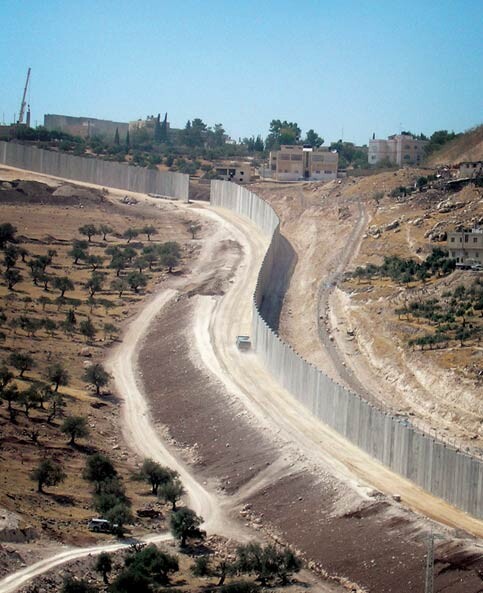The Electronic Intifada 5 May 2005

Israel’s Apartheid Wall under construction in occupied East Jerusalem. (Arjan El Fassed)
The scene is tragic and unnerving but it has become astonishingly routine — the deadly routine that imposes ordinariness on the outrageous and unconscionable.
The checkpoint at Qalandia is taking shape irrevocably as a permanent bottleneck and border crossing that cuts off the illegally annexed East Jerusalem along with some 28 Palestinian villages from the rest of the West Bank.
There is a substantial amount of small commerce that has cropped up around this roadblock. The place has the look of a flea market. You can find men and boys hawking everything, from vegetables to cheap household goods, to books to live chickens to flowers to shish kebabs. The colourful umbrellas that the vendors set up for shade look incongruously festive among the rubble, but they can’t hide the litter that is piling up or the polluted water trenches or the dust.
There is also the daily chaos and congestion of cars, trucks and vans, and of Palestinian pedestrians, young and old, making passage and submitting themselves to checking as they exit from the Ramallah side to the East Jerusalem side and back again. Around this hub is the din of heavy machinery pulverising rock and levelling the high ground right next to the checkpoint structure with its turnstile gate. So far, the digging has left intact the rock on which an Israeli lookout is perched.
Soon construction for a border police building will commence on this flattened ground, and the seemingly innocuous-sounding words “checkpoint” or “roadblock” will be transformed into a respectable, legitimate-looking border crossing, a fact on the ground as solid as the long concrete wall it faces.
To add insult to injury, the new structure will be built by Palestinian labour, as was the wall. It will likely have the civilised look of the administration buildings recently refurbished at the Allenby Bridge, where Palestinians work as porters and janitors: matching colours and modern furniture design, air-conditioning and VIP transport — an ordinary administrative veneer that fails to hide the ugliness of its intent or the history of its reality.
What’s truly unnerving about this scene at Qalandia is how easily and smoothly it is taking shape. You don’t even see a show of force on the Israeli side beyond the heavy construction machinery and a few Israeli soldiers with guns who man the roadblock and herd Palestinians this way or that, while the grand design around them slowly but inexorably unfolds.
The Palestinians, in turn, simply step over the rocks or dirt, wait in lines with their minds on their immediate, mundane and individual troubles. They pull out their various IDs and permits on demand; they jockey for position; they hurriedly shop from the various vendors milling about as they head to their homes or their work; they are grateful for the transportation they find, glad that they had made it for the day, as are the drivers whose taxies are parked in the congested spaces on either side of the roadblock.
It takes one Israeli soldier, one gun and a barked command to push them this way or that. None understands how travel between Ramallah and East Jerusalem is likely to change in the near future; they are intent on navigating their way day by day. Some are still in denial, believing naively that justice will come with negotiations if and when these take place.
But in the scene unfolding at Qalandia, there is absolutely no indication of a solution with justice. This border, the face of the annexation of East Jerusalem and environs, is the face of an imposed problem, not of a solution. When Israel finishes its work, Abbas will be invited to sign off.
The pattern is one that the Israelis have used not only in their occupation and settlement of the West Bank and Gaza, but also in their settlement of Israel proper.
If you travel in both Israel and the West Bank, you will not need a tour guide to see this pattern. Both inside Israel and on the West Bank, Palestinian villages and towns (the ones that haven’t been erased from the map entirely) are surrounded by Jewish settlements, their common lands confiscated, their water resources depleted or gone. The Jewish settlements are provided with superior roads and public services; the Palestinian ones are impoverished. But most crucially, land is grabbed from Palestinians in various ways and means and transferred into Jewish hands. The rights of displaced Palestinians or refugees are enshrined in international law that Israel refuses to acknowledge.
And yet, Israel is looking to the international community to mop up the mess Israel has created as a result of its continued dehumanisation of the Palestinians and denial of their most fundamental rights as a people. Great minds are already applying themselves to the puzzler of how to make bits and pieces of land viable economically. The latest Rand report on the subject is estimating $33 billion in capital investment in the first ten years, with $6 billion going to the core rail and road infrastructure for a “corridor” from the northern West Bank to Gaza.
Israel wants peace, yes, but entirely on its own terms.
Rima Merriman is a freelance writer and a communications specialist. She worked in the West Bank for four months in late 2004. This article first appeared in the Jordan Times on 5 May 2005.





